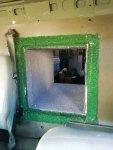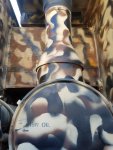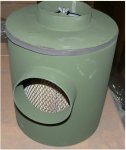I don't think making the pass through is that difficult, it may just require a little creativity. I'm a mechanical design engineer, so thinking about stuff like this gets me excited.
1. Don't worry about the distance (2') between the cab and the box. All you have to do to solve that problem is make a fixed extension. So the box would have a 1'8" rigid tunnel that comes off it, for example, which would be braced well and sturdy. That only leaves you with a 4" (or other appropriately small but functional) gap to bridge, with your accordion seal. Add a little flip down hinged bridge inside the tunnel, that gives you a firm floor to cross that gap (it would bridge to a sturdy point in the cab, never touching the seal).
2. You can have the accordion seal attached firmly to the box tunnel and the cab, you just have to add a quick disconnect mechanism. As long as it doesn't take too much time and effort to remove, you should be fine. There are SO many ways you could approach that, my brain is going crazy just thinking about it...
- A. Something like an ammo can lid, with the center cut out like a picture frame. The tunnel/seal would pass through the picture frame. To hook/unhook it, you would flip a big latch that would release one side, then open it far enough that it can pull off/out of some mechanism that just hooks into on the other side (it could be a hinge-pin like mechanism similar to the ammo can where it slide sideways, or just a ledge that the toe of the frame hooks under, or any number of other things). This is how a lot of computer CPU retention brackets work too:
http://techreport.com/r.x/system-build-howto/socketdrop.jpg
- B. More work to put on and off, but you could also just have a similar metal picture frame that pushes down on the seal with several evenly spaced quick disconnect fasteners around the perimeter. Like a big version of these sliding panel latches, for example:
https://www.pegasusautoracing.com/productdetails.asp?RecID=4660
- C. You could even take off the hydraulic cylinders used to compress the suspension for shipping (because who uses those?), and use that hydraulic line to actuate a hydraulic system to compress and latch it in place. That would be super slick, because you would operate it from the knobs right there in the control box, in the same place you're about to raise the cab from following releasing the accordion seal!
As for sealing without leaking or being drafty, this seems like a simple non-issue. Just build a small flanged extension out from the cab, with a small depth of maybe 1-2". Since that flange would point outwards in all directions, your accordion seal would sit around it and create an indirect path that water and air don't flow into. You could even fill the flange gap with a buffer material (e.g. rubber, felt, etc.). You can kind of see how there is a protruding flange on the lip of this NEMA electrical enclosure, that presses into the seals in the doors:
https://cdn.nexternal.com/solutionsd/images/snb-series-400.jpg
Overall, my point is that there really isn't anything about this project that poses great difficulty. At most these problems have been solved in other industries and you just have to incorporate their novel designs. It should be fun! So choose the LMTV!





